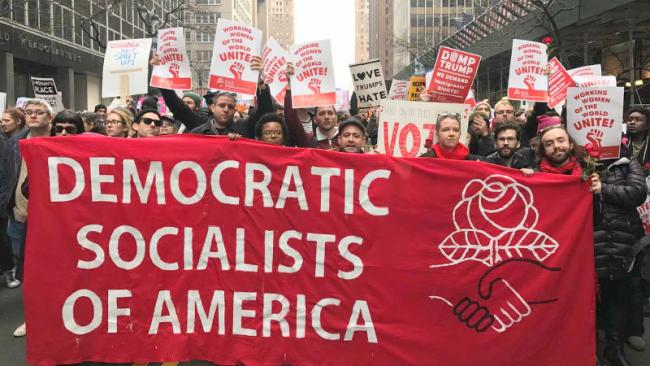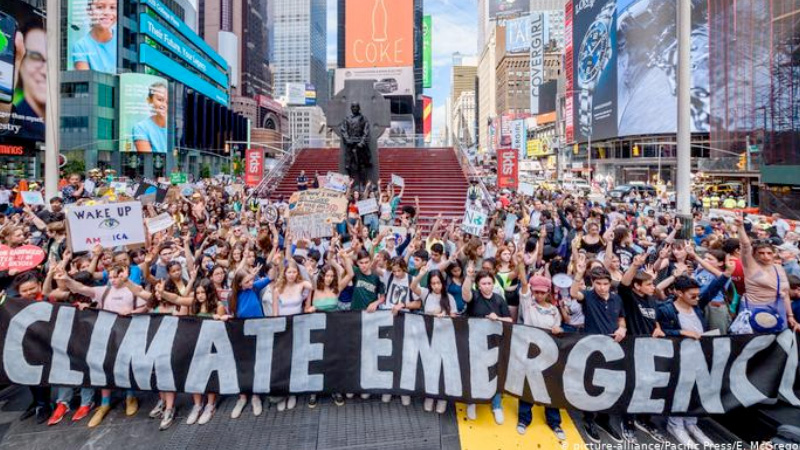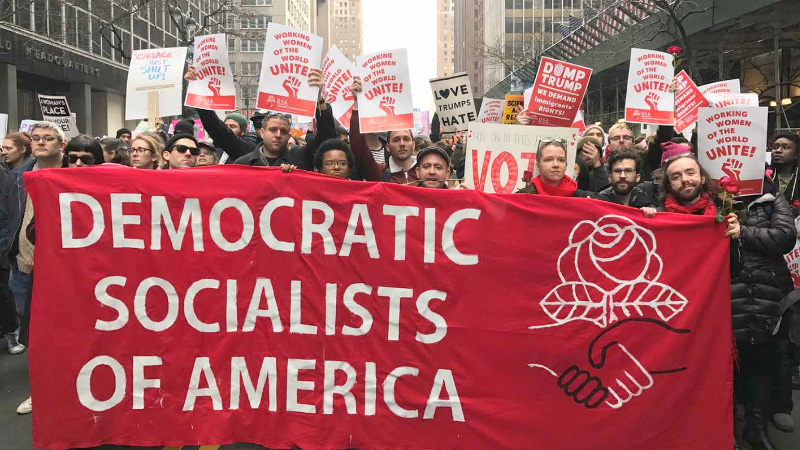Articles Menu

[ Interesting Assessment Of The Democratic Socialists Of America - Will Offley]
In this piece, veteran socialist Mel Bienenfeld, provides an overview and assessment of DSA’s approach to social movements based on the historic approach to these questions by the revolutionary socialist tradition.
[I]t is clear that the mass strike cannot be called at will, even when the decision to do so may come from the highest committee of the strongest social democratic [socialist] party … If, however, the direction of the mass strike in the sense of command over its origin … is a matter of the revolutionary period itself, the directing of the mass strike becomes, in an altogether different sense, the duty of social democracy and its leading organs. … the social democrats are called upon to assume political leadership in the midst of the revolutionary period.
— Rosa Luxemburg, The Mass Strike, the Political Party and the Trade Unions
For the first time since at least the 1960’s, the world is experiencing an extended wave of struggle involving millions. In one country after another, people have mobilized in the tens and hundreds of thousands, in response to the consequences of neoliberal capitalism: economic crisis, systematic racism, government austerity, climate change, state violence, gender oppression, shootings in schools (and elsewhere), migration, and threats to workplace health.
These mobilizations arise as part of a general global phenomenon of political polarization and radicalization. In the United States this has led to the explosive growth of the Democratic Socialists of America (DSA), a socialist organization whose membership numbers now rival those of the Communist and Socialist parties of the Great Depression and World War II eras.
The question of how the DSA relates to the ongoing global movement—particularly the huge, unanticipated revolt against police violence and racism in this country—is now squarely on the agenda. Social movements are not likely to abate, as capitalism’s crisis continues to unfold, now and in the post-pandemic near future. Without a systematic consideration of how socialists ought to regard these movements and their own involvement in them, the opportunity for the movements’ cohering into a force that can challenge the rule of capital—and its drive towards social and environmental devastation—will pass us by.
This essay is an attempt to characterize how DSA has thus far responded to the mass upsurge, and then to make some suggestions regarding what that response could, and should, be. The examples given are mostly specific to DSA’s New York City Chapter, but I believe they are generally characteristic of the organization as a whole.
On September 20, 2019, some four million protestors filled the streets of major cities worldwide, demanding immediate, radical action to limit climate change. The huge numbers and deep passion of the marchers, mostly young, and many inspired by the fearless and precocious Greta Thunberg, showed the extent of their generation’s anger toward society’s rulers for sacrificing the human and natural future to economic pressures and political expediency.

In New York that day, hundreds of thousands of these demonstrators streamed towards a Battery Park rally, carrying colorful, creative signs and banners, and maintaining high energy with chants and songs. Their slogans revealed a sophisticated understanding of the role of the fossil fuel industry, its political defenders and enablers, and their failure to slow the global warming that they have actively aided and abetted.
DSA, however, remained mostly aloof. Neither the national organization nor its New York City Chapter endorsed the Climate Strike. No unit of DSA played any significant role in building it.
Within DSA most specific movement issues are the responsibility of “working groups” which do not necessarily coordinate activities with the organization as a whole. The result, as in the case of the Climate Strike, was that a small contingent (perhaps 20-30) of DSAers marched together as members of the New York Chapter’s Ecosocialist Working Group. They carried DSA flags and distributed literature about the group’s support for the (Congressional) Green New Deal. If other DSA members—in a chapter modestly estimated at about ten thousand—attended the march, it was as unidentified individuals. There was no organized presence beyond the Working Group.
As a longtime socialist who attended the march it took me some time to understand the logic of why a socialist group would behave in such an apparently self-isolating way. I was aware of the overwhelming importance DSA attached to Bernie Sanders’ presidential candidacy, and had some sense of the door knocking and phone banking its members were doing in advance of the 2020 Primary season. But I did not yet fully understand that “building socialism,” to the DSA leadership, meant putting a political priority on elections, campaigning for legislative reforms, and urging people to join the organization.
About eight months later, in the midst of the COVID-19 pandemic, the police murder of George Floyd led to an even more inspiring and profound global wave of protests. This time DSA’s response has been quite different, though still problematic.
To its credit, the New York City Chapter organized an online chapter-wide meeting featuring reports on the demand to defund (and eventually abolish) the police, the participation of members in the protests, and the Chapter’s strategy for achieving the demand. In the ensuing weeks branch leadership committees within the chapter tracked demonstrations happening in each geographical area and contacted members, encouraging them to participate. And, in a significant departure from the Chapter’s practice, the Racial Justice Working Group (RJWG) and Afrosocialist Caucus pulled together a march and rally with over 50 co-sponsoring organizations. This action took place on the eve of the City Council meeting at which measures sharply curtailing the Police Department budget were to be voted on. (The next day, after a budget was passed without significant PD cuts, the RJWG returned to City Hall and vowed to continue its alliance with those who had been conducting an “Occupy” action in City Hall Park.)
Still, the Chapter as a whole did not engage in any systematic planning regarding what its relationship to the huge antiracist, anti-police revolt, ought to be. First, it is notable that it was still left to working groups, in this case the RJWG and the Afrosocialist caucus—to do the work. Second, there was little, if any, attempt to understand who the protestors were; to consider why millions of young white people returned day after day to stand alongside people of color demanding racial justice in the middle of a pandemic; to establish ongoing relationships with the groups planning the marches (and potentially to the multitude of participants), or to ask what a socialist organization—with its understanding of capitalist society, its historical knowledge of how movements exert power, and its resources—had to offer regarding the potential direction and strategy for this new and rapidly radicalizing movement. Seeming to ignore the power of the very street movement members were encouraged to participate in (as individuals, not as an organized contingent), Chapter leaders at the online meeting reminded members that the plan for DSA’s organizational role in defunding the NYPD consisted of getting as many DSA members as possible to urge their City Council members to vote favorably (with no effort to encourage non-DSAers to do the same), and to elect as large a slate of DSA-endorsed candidates as possible in the 2021 Council elections. The group’s organizational role seemed reduced to an aggregation of the responsibility of its individual members to act.
If there has been a change in DSA’s attitude towards mass movements, it may or may not represent the beginning of an evolution in the organization’s self-conception. It would be facile—and inaccurate—to say that this is simply the result of the fact that Bernie Sanders is no longer a candidate. (This especially in light of the effort DSA continues to put into its endorsed candidates; taking great encouragement from the victory of some of those candidates in the New York and Kentucky primary elections.) But the vast wave of the Black Lives Matter protests has seemed to help revive an organization struggling to retain enthusiasm after its singular hope for a national political victory evaporated.
There has always been something of a disconnect between recent DSA theory and practice as it relates to mass movements. On the one hand, some members have sought to justify the inordinate amount of resources and attention given over to electoral work. For example, Paul Heideman has argued that it is only electoral campaigns, typified by Bernie Sanders, that can succeed in convincing millions that their needs are best met by “supporting a socialist”. He counterposes these electoral efforts to the sort of movement activity exemplified by the Occupy protests of 2011, which, in his view, limited themselves to a narrow segment of participants who shared certain cultural habits. “Social movements, like the antiwar movement or Black Lives Matter, broke out of this narrowness and attempted to mobilize people on a mass scale. But their mobilizations were sporadic and short-lived.” With Sanders’ withdrawal, Heideman sees the revived danger of “movementism” as the left retreats into “comfortable” old habits. While Heideman’s piece has been subject to sharp criticism, it does reflect an apparent common-sense among the DSA leadership.
Nonetheless, DSA literature always recognized that elections by themselves would be insufficient to achieve socialism. This too represents a common sense within the organization, albeit one held in tension with the dominant electoralist strategy. There were always individuals and subordinate units within DSA urging organizational involvement within such movements, with a minority arguing that this be a priority. Some of the Working Groups certainly involved members in actions beyond DSA itself (notably on immigration, for example). And in a group that takes seriously its aspiration to represent the working class and sees an important role for organized labor, the importance of the 2018-19 teachers’ strikes was not lost. But at the height of the antiracist revolt, as the primary season continued, elections remained DSA’s top priority. For example, on June 16, during the upsurge following George Floyd’s murder, an email from the NYC Chapter Steering Committee, entitled “Paint NYC Red: Get Out the Vote,” read, “If you do one thing this week, it should be this.”
Good examples of the tensions and contradictions in the DSA approach to the recent rebellion are found in the website of the Bread and Roses (B&R) Caucus, one of the two main caucuses making up the leadership bloc within DSA. In the B&R newsletter, The Call, Chicago DSA member, Ramsin Canon, refers to what he calls a “good initial impulse” among DSA members not to insert themselves organizationally into a Black-led movement, both because DSA is still overwhelmingly white, and because the history of socialist interventions have too often been to hijack them for the socialist group’s own purposes. Canon acknowledges that socialist organizations “can’t afford not to be involved in providing solidarity and even leadership in an uprising against white supremacy that is central to creating a unified and self-aware working class movement.” [Emphasis added]. “DSA can’t shirk its responsibility.” These are important observations, but for the inexperienced DSA they require an explanation and elaboration that the article itself does not provide.
Canon’s article does provide some important insights. He recognizes that without serious internal political discussion DSA will not be able to come to an understanding of what its role ought to be. He also acknowledges the integrity of the movement itself: “The guiding star is following and being part of an organic movement” [emphasis in original]. He specifically raises the question of what an “organization with a socialist vision” can provide, but refrains from offering an answer. While the article is an important and welcome contribution, it is just a bare beginning.
How far we have to go, I think, is indicated by some of the discussion during a June 22, 2020 online forum on “Defunding the Police,” organized by B&R. The moderator asked about the role of DSA and organized socialists in the defunding movement. Like Canon’s article, the reply began from a theoretically sound starting point (the road to socialism is through anti-racism and anti-police violence), but the speakers offered little in the way of what DSA has to offer to the movement. One speaker emphasized the need for DSA members to be involved in workplaces and working-class communities; another mentioned that DSA can show how racism and capitalism are related, referring to the “organized campaigns” that activists can become part of by joining DSA itself. When the question was posed as to how to bridge the gap between the spontaneity of the movement and the need for lasting organization, the speakers agreed that the need for lasting organization is important, but the only suggestion on how to achieve it was to attract people to DSA itself.
This last response is a serious error and points primarily to the immaturity of DSA as an activist organization. I don’t necessarily blame the speakers themselves, but neither do I believe it was just an oversight in a moment of pressure in a public forum. DSA as an organization does in fact see its role in various arenas of struggle as constructing “organized campaigns” carried out by DSA members themselves (usually with little or no involvement of other groups). The example of defunding the New York City police, in which Chapter leaders urge DSAers to pressure their City Council members and then get out the vote in 2021 when a new Council is elected, is not an isolated one.
This “organized campaigns” model is in fact the obverse of the methodology in which the socialist organization attempts to turn the movement into its front group. Both models see the activity of the socialist organization itself as what best advances the movement’s goals, or at least what it sees as the “socialist” aspect of those goals. Both fail to understand how a movement arising from historical circumstances has its own dynamics, its ups and downs, its internal and potential divisions, and its successes and failures. The movement as it really is may not fit the predetermined plan of a socialist organization, but has an impact and historic import that must not be ignored.
For a socialist organization, recognition of the independent existence of a social movement, rather than an obstacle to successful intervention, is a prerequisite for doing so. In order to actualize the theoretical link between ending class exploitation and the related forms of oppression (like racism) that capitalism perpetuates, movements have to be understood as they really are. With a century and a half of historical experience—going back to Marx’ and Engels’ support for Irish nationalism—involving socialist organizations intervening in both non-workplace struggles and those directly pitting workers against capitalist employers, we ought to be able to work out some principles regarding how socialists can use such understanding to help advance the movements and deepen their connection to the socialist goal.

I’m far from claiming the capacity to be able accomplish this as an individual. But I do want to offer some suggestions. These are meant as a starting point, not an ending point:
Ending where we began, with Luxemburg, we must concede that our time, of course, is not a revolutionary period; nor is DSA a political party. But as we observe a broad, explosive, sustained, and highly conscious antiracist movement come into being, it ought to be clear that a rapidly growing socialist organization cannot afford to avoid a serious, systematic, wide-ranging, and democratic inquiry into what its role in the movement should be.